2010 FORD SUPER DUTY check engine light
[x] Cancel search: check engine lightPage 9 of 104

Glow plug pre-heat indicator:
With the key in the on position,
the
light will illuminate if glow
plug heat is necessary as a starting aid. Wait until the light goes off
before starting. Refer toCold weather startingin theDrivingchapter
of this supplement. After the engine starts, the light should turn on. The
light should always illuminate at least momentarily when the engine is
cold and the ignition is turned to on. If it does not illuminate, the glow
plug system should be checked and repaired promptly to avoid difficulty
in cold starting.
Water in fuel:
F-Super Duty
E-Series
During refueling, it is possible for water-contaminated diesel fuel to be
pumped into your tank. Your vehicle’s fuel system is equipped with a fuel
filter/water separator to remove water from the fuel. The water in fuel
light will illuminate when the FCM/HFCM has a significant quantity of
water in it.
If the light illuminates when the engine is running, stop the vehicle as
soon as safely possible, shut off the engine, then drain the FCM/HFCM.
Refer toDraining the FCM/HFCM and changing the fuel filtersin the
Maintenance and Specificationschapter of this supplement for the
drain procedure. Allowing water to stay in the system could result in
extensive damage to, or failure of, the fuel injection system.
WARNING:Do not drain the water separator while the engine is
running. Fuel may ignite if the separator is drained while the
engine is running or the vehicle is moving.
Instrument Cluster
9
2010 Econoline(eco)
Supplement(supplement), 1st Printing
USA(fus)
Page 14 of 104

COLD WEATHER OPERATION
Changing to a lighter grade engine oil also makes starting easier under
these conditions. Refer toEngine oil specificationsin theMaintenance
and Specificationschapter of this supplement.
Diesel fuel is adjusted seasonally for cold temperatures. Diesel fuel which
has not been properly formulated for the ambient conditions may form
wax crystals which can clog the fuel filter. At temperatures below 20°F
(–7°C), if the engine starts, stalls after a short time, and then will not
restart, the fuel filter(s) may be clogged. For best results in cold
weather, use a diesel fuel which has been formulated for the ambient
conditions. If you have been using biodiesel, you may need to use a fuel
with lower biodiesel content, try another brand, or discontinue using
biodiesel.
Your vehicle is equipped with either an FCM or HFCM which recirculates
fuel from the engine to help prevent fuel filter clogging. Your vehicle is
also equipped with a bypass relief valve, located in the fuel tank pick-up
boot, which provides fuel flow to the engine if the fuel pickup should
become plugged. To allow the bypass valve to function and avoid engine
fuel starvation during cold weather operation of 32°F (0°C) or below, it
is recommended that the fuel level in your tank should not be allowed to
drop below
1�4full. This will help prevent air from entering the fuel
system and stalling the engine.
In cold weather below 32°F (0°C), the engine will slowly increase to a
higher idle speed if left idling in P (Park). As the engine warms-up, the
engine sound level will decrease due to the activation of PCM-controlled
sound reduction features.
If your vehicle is operated in a heavy snow storm or blowing snow
conditions, the engine air induction may become partially clogged with
snow and/or ice. If this occurs, the engine may experience a significant
reduction in power output. At the earliest opportunity, clear all the snow
and/or ice away from inside the air filter assembly. Take the top off the
assembly, leaving the air filter in, and remove any snow or ice.
In order to operate the engine in temperatures of 32°F (0°C) or lower,
read the following instructions:
•Make sure that the batteries are of sufficient size and are fully
charged. Check other electrical components to make sure they are in
optimum condition.
•Use Motorcraft Premium Engine Coolant solution at the concentration
recommended to protect the engine against damage from freezing.
•Try to keep the fuel tank full as much as possible at the end of
operation to prevent condensation in the fuel system.
Driving
14
2010 Econoline(eco)
Supplement(supplement), 1st Printing
USA(fus)
Page 41 of 104
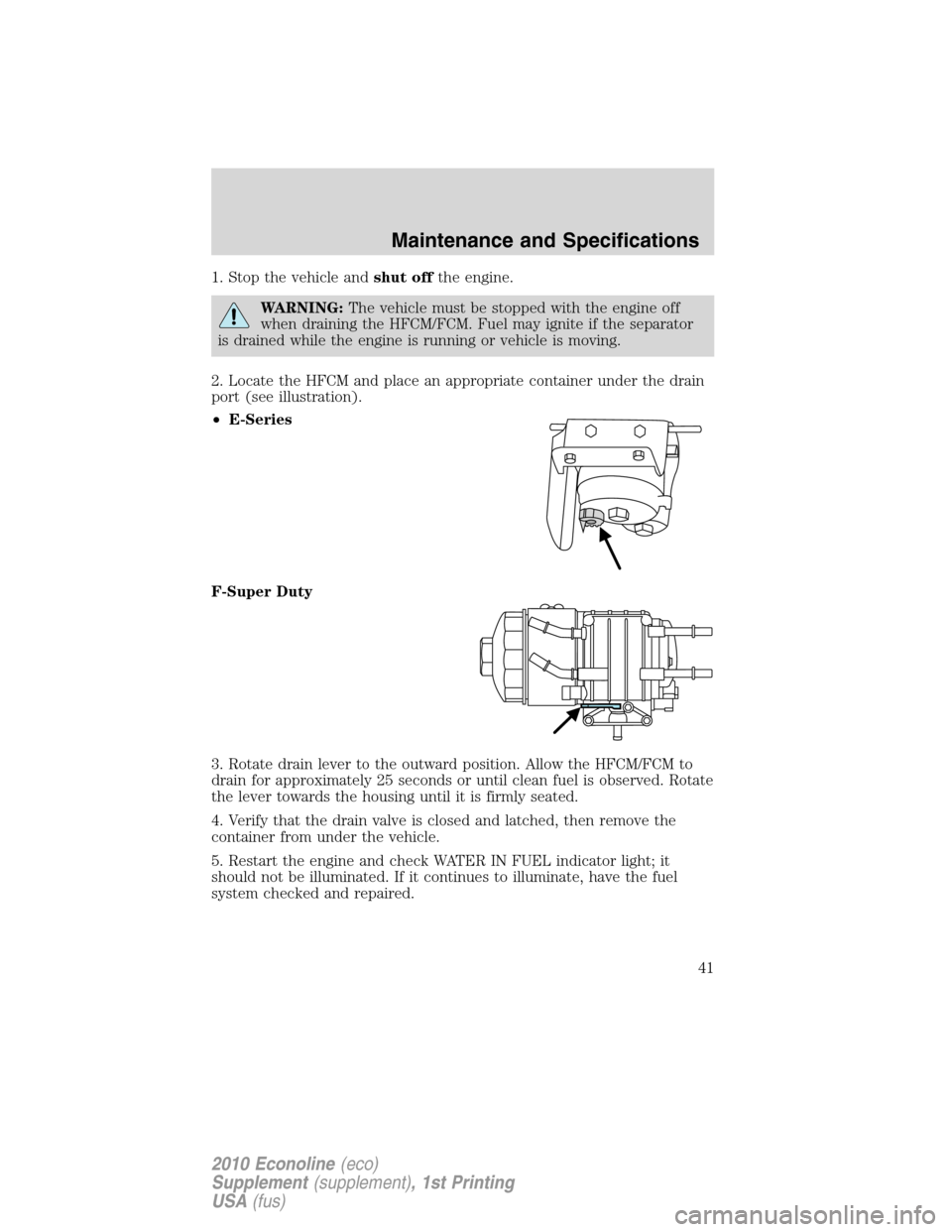
1. Stop the vehicle andshut offthe engine.
WARNING:The vehicle must be stopped with the engine off
when draining the HFCM/FCM. Fuel may ignite if the separator
is drained while the engine is running or vehicle is moving.
2. Locate the HFCM and place an appropriate container under the drain
port (see illustration).
•E-Series
F-Super Duty
3. Rotate drain lever to the outward position. Allow the HFCM/FCM to
drain for approximately 25 seconds or until clean fuel is observed. Rotate
the lever towards the housing until it is firmly seated.
4. Verify that the drain valve is closed and latched, then remove the
container from under the vehicle.
5. Restart the engine and check WATER IN FUEL indicator light; it
should not be illuminated. If it continues to illuminate, have the fuel
system checked and repaired.
Maintenance and Specifications
41
2010 Econoline(eco)
Supplement(supplement), 1st Printing
USA(fus)
Page 48 of 104
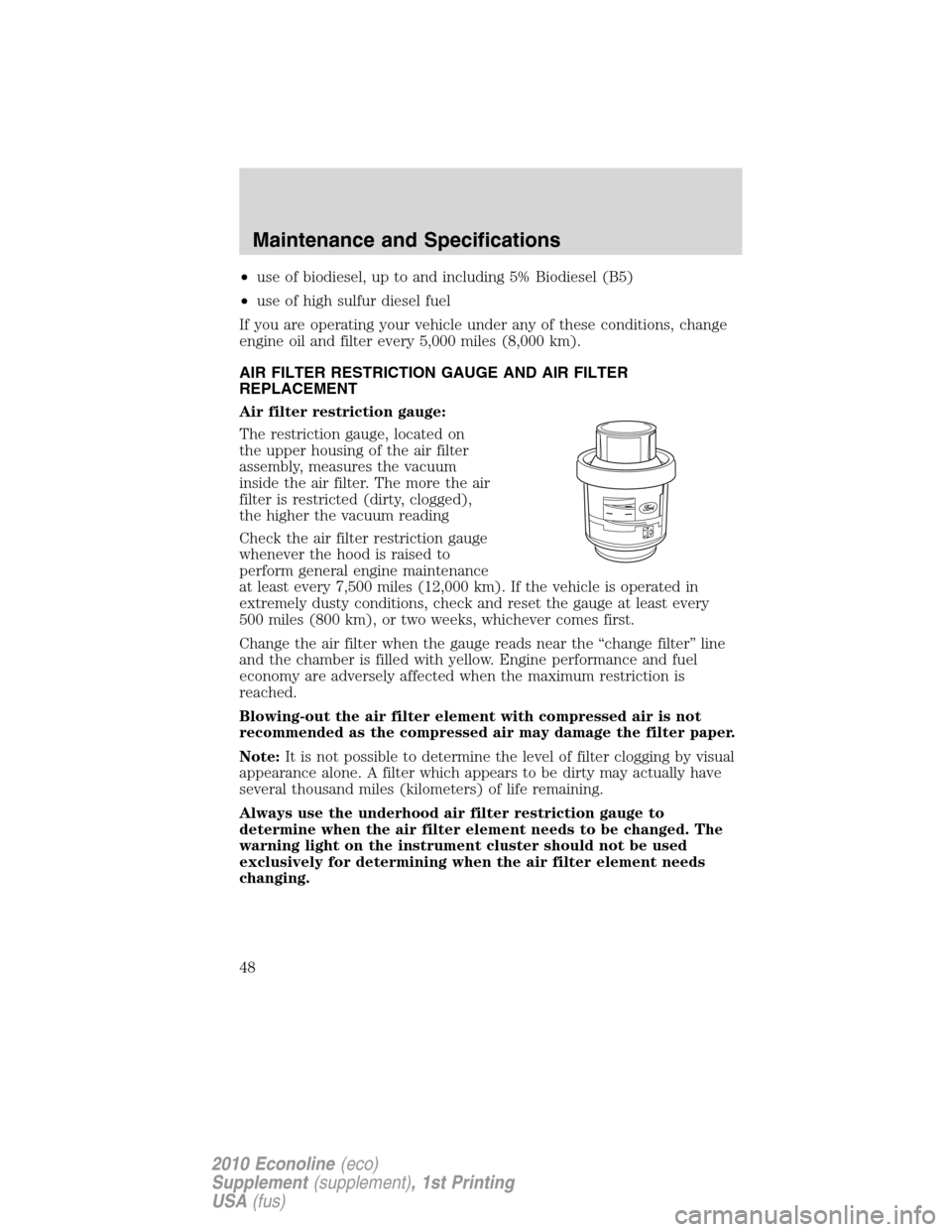
•use of biodiesel, up to and including 5% Biodiesel (B5)
•use of high sulfur diesel fuel
If you are operating your vehicle under any of these conditions, change
engine oil and filter every 5,000 miles (8,000 km).
AIR FILTER RESTRICTION GAUGE AND AIR FILTER
REPLACEMENT
Air filter restriction gauge:
The restriction gauge, located on
the upper housing of the air filter
assembly, measures the vacuum
inside the air filter. The more the air
filter is restricted (dirty, clogged),
the higher the vacuum reading
Check the air filter restriction gauge
whenever the hood is raised to
perform general engine maintenance
at least every 7,500 miles (12,000 km). If the vehicle is operated in
extremely dusty conditions, check and reset the gauge at least every
500 miles (800 km), or two weeks, whichever comes first.
Change the air filter when the gauge reads near the “change filter” line
and the chamber is filled with yellow. Engine performance and fuel
economy are adversely affected when the maximum restriction is
reached.
Blowing-out the air filter element with compressed air is not
recommended as the compressed air may damage the filter paper.
Note:It is not possible to determine the level of filter clogging by visual
appearance alone. A filter which appears to be dirty may actually have
several thousand miles (kilometers) of life remaining.
Always use the underhood air filter restriction gauge to
determine when the air filter element needs to be changed. The
warning light on the instrument cluster should not be used
exclusively for determining when the air filter element needs
changing.
Maintenance and Specifications
48
2010 Econoline(eco)
Supplement(supplement), 1st Printing
USA(fus)
Page 56 of 104
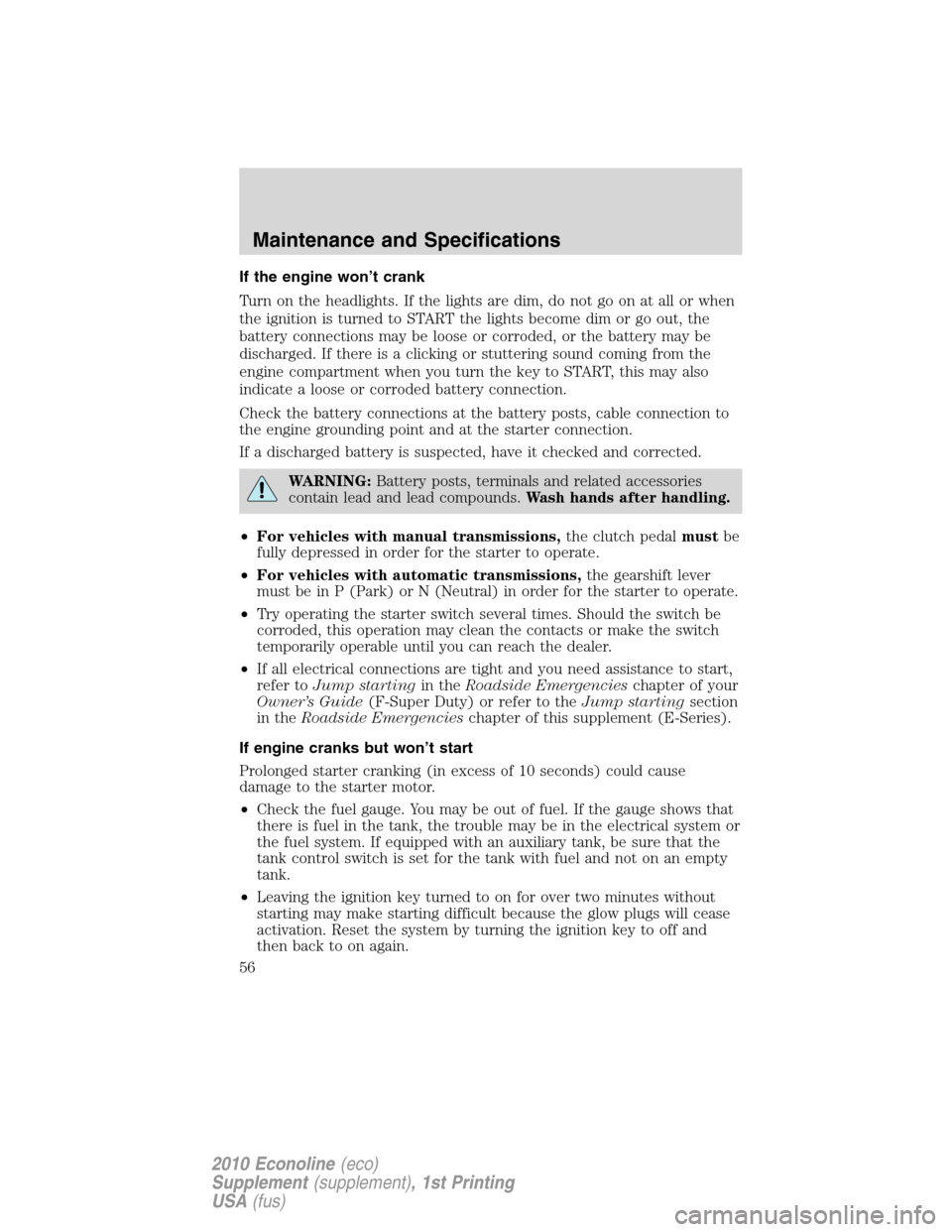
If the engine won’t crank
Turn on the headlights. If the lights are dim, do not go on at all or when
the ignition is turned to START the lights become dim or go out, the
battery connections may be loose or corroded, or the battery may be
discharged. If there is a clicking or stuttering sound coming from the
engine compartment when you turn the key to START, this may also
indicate a loose or corroded battery connection.
Check the battery connections at the battery posts, cable connection to
the engine grounding point and at the starter connection.
If a discharged battery is suspected, have it checked and corrected.
WARNING:Battery posts, terminals and related accessories
contain lead and lead compounds.Wash hands after handling.
•For vehicles with manual transmissions,the clutch pedalmustbe
fully depressed in order for the starter to operate.
•For vehicles with automatic transmissions,the gearshift lever
must be in P (Park) or N (Neutral) in order for the starter to operate.
•Try operating the starter switch several times. Should the switch be
corroded, this operation may clean the contacts or make the switch
temporarily operable until you can reach the dealer.
•If all electrical connections are tight and you need assistance to start,
refer toJump startingin theRoadside Emergencieschapter of your
Owner’s Guide(F-Super Duty) or refer to theJump startingsection
in theRoadside Emergencieschapter of this supplement (E-Series).
If engine cranks but won’t start
Prolonged starter cranking (in excess of 10 seconds) could cause
damage to the starter motor.
•Check the fuel gauge. You may be out of fuel. If the gauge shows that
there is fuel in the tank, the trouble may be in the electrical system or
the fuel system. If equipped with an auxiliary tank, be sure that the
tank control switch is set for the tank with fuel and not on an empty
tank.
•Leaving the ignition key turned to on for over two minutes without
starting may make starting difficult because the glow plugs will cease
activation. Reset the system by turning the ignition key to off and
then back to on again.
Maintenance and Specifications
56
2010 Econoline(eco)
Supplement(supplement), 1st Printing
USA(fus)
Page 64 of 104
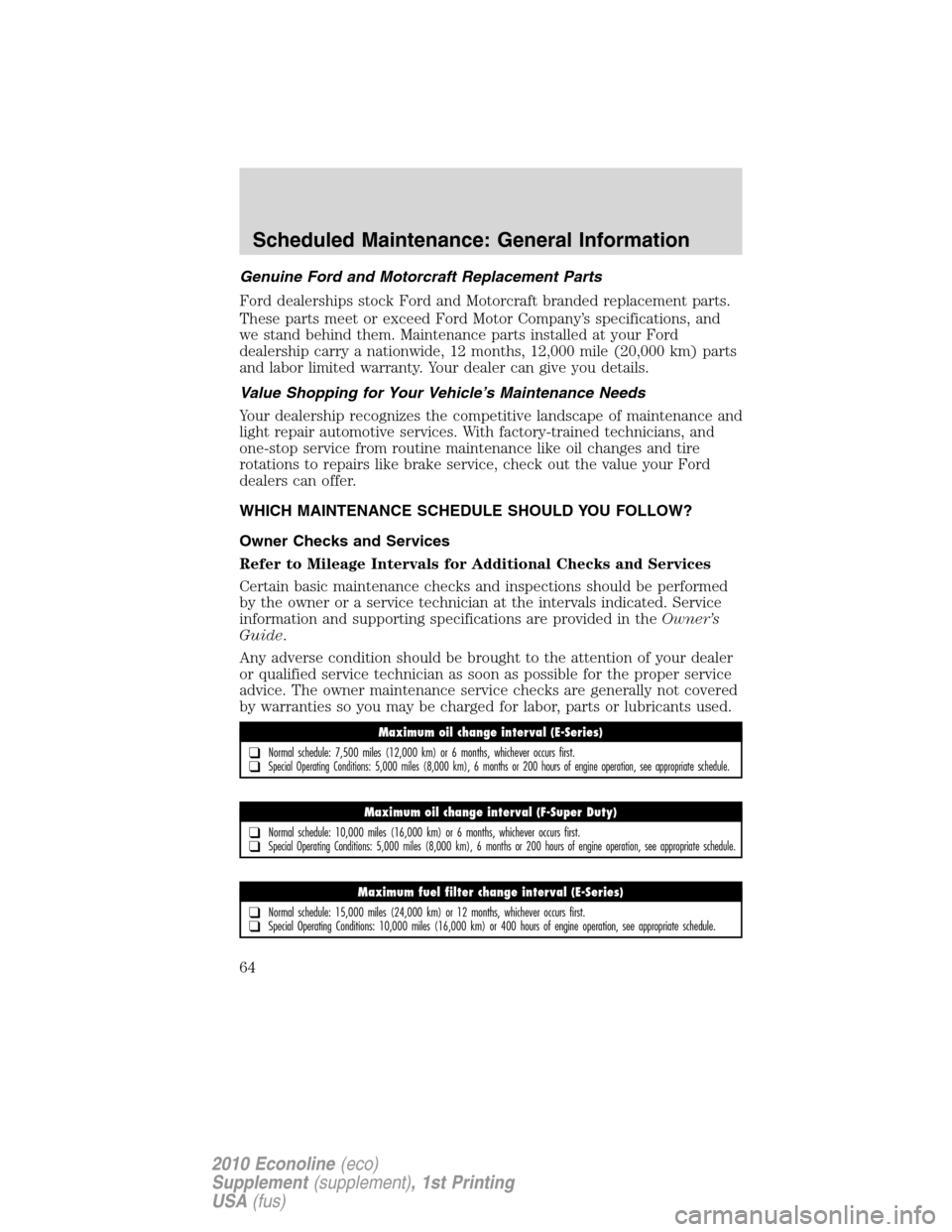
Genuine Ford and Motorcraft Replacement Parts
Ford dealerships stock Ford and Motorcraft branded replacement parts.
These parts meet or exceed Ford Motor Company’s specifications, and
we stand behind them. Maintenance parts installed at your Ford
dealership carry a nationwide, 12 months, 12,000 mile (20,000 km) parts
and labor limited warranty. Your dealer can give you details.
Value Shopping for Your Vehicle’s Maintenance Needs
Your dealership recognizes the competitive landscape of maintenance and
light repair automotive services. With factory-trained technicians, and
one-stop service from routine maintenance like oil changes and tire
rotations to repairs like brake service, check out the value your Ford
dealers can offer.
WHICH MAINTENANCE SCHEDULE SHOULD YOU FOLLOW?
Owner Checks and Services
Refer to Mileage Intervals for Additional Checks and Services
Certain basic maintenance checks and inspections should be performed
by the owner or a service technician at the intervals indicated. Service
information and supporting specifications are provided in theOwner’s
Guide.
Any adverse condition should be brought to the attention of your dealer
or qualified service technician as soon as possible for the proper service
advice. The owner maintenance service checks are generally not covered
by warranties so you may be charged for labor, parts or lubricants used.
Maximum oil change interval (E-Series)
❑Normal schedule: 7,500 miles (12,000 km) or 6 months, whichever occurs first.❑Special Operating Conditions: 5,000 miles (8,000 km), 6 months or 200 hours of engine operation, see appropriate schedule.
Maximum oil change interval (F-Super Duty)
❑Normal schedule: 10,000 miles (16,000 km) or 6 months, whichever occurs first.❑Special Operating Conditions: 5,000 miles (8,000 km), 6 months or 200 hours of engine operation, see appropriate schedule.
Maximum fuel filter change interval (E-Series)
❑Normal schedule: 15,000 miles (24,000 km) or 12 months, whichever occurs first.❑Special Operating Conditions: 10,000 miles (16,000 km) or 400 hours of engine operation, see appropriate schedule.
Scheduled Maintenance: General Information
64
2010 Econoline(eco)
Supplement(supplement), 1st Printing
USA(fus)
Page 65 of 104
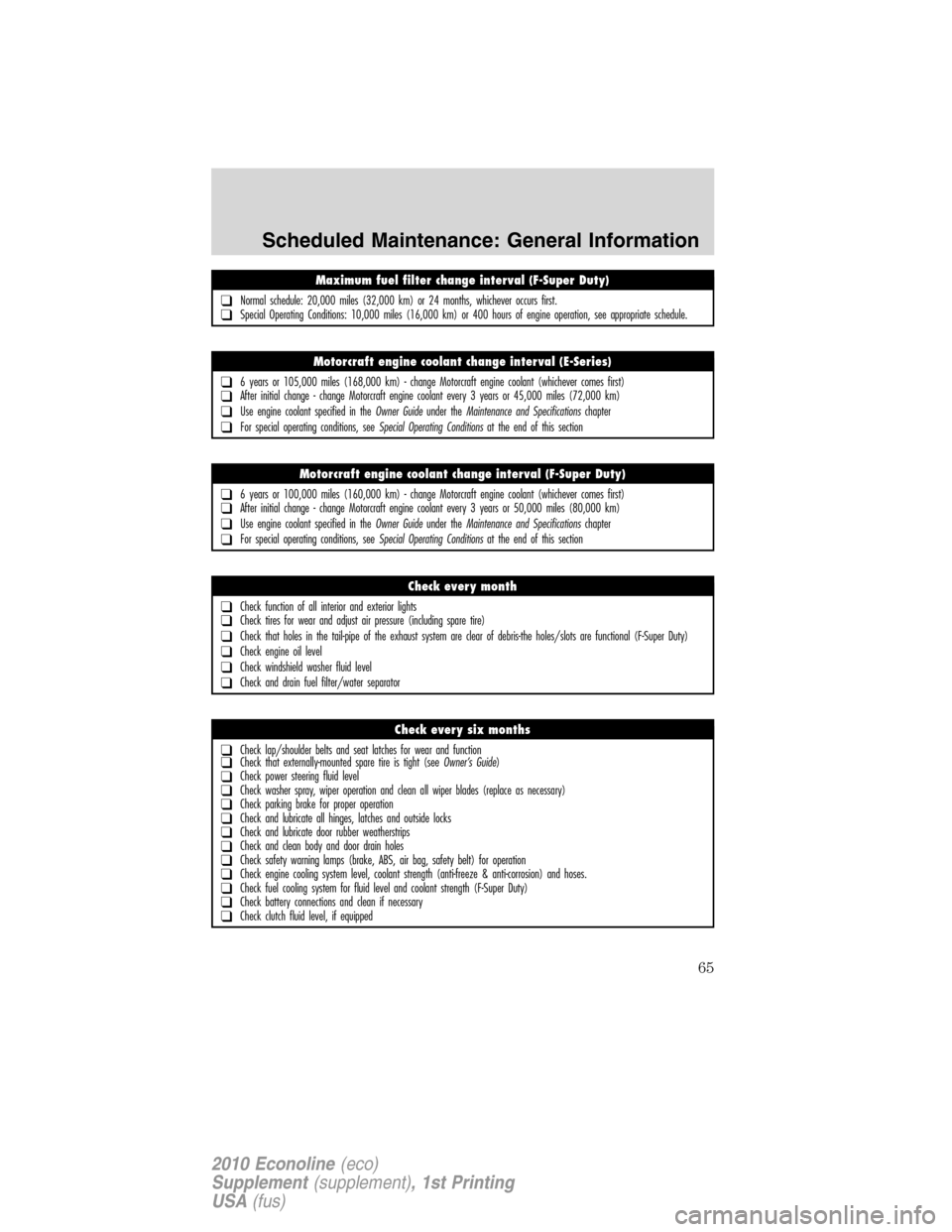
Maximum fuel filter change interval (F-Super Duty)
❑Normal schedule: 20,000 miles (32,000 km) or 24 months, whichever occurs first.❑Special Operating Conditions: 10,000 miles (16,000 km) or 400 hours of engine operation, see appropriate schedule.
Motorcraft engine coolant change interval (E-Series)
❑6 years or 105,000 miles (168,000 km) - change Motorcraft engine coolant (whichever comes first)❑After initial change - change Motorcraft engine coolant every 3 years or 45,000 miles (72,000 km)
❑Use engine coolant specified in theOwner Guideunder theMaintenance and Specificationschapter
❑For special operating conditions, seeSpecial Operating Conditionsat the end of this section
Motorcraft engine coolant change interval (F-Super Duty)
❑6 years or 100,000 miles (160,000 km) - change Motorcraft engine coolant (whichever comes first)❑After initial change - change Motorcraft engine coolant every 3 years or 50,000 miles (80,000 km)
❑Use engine coolant specified in theOwner Guideunder theMaintenance and Specificationschapter
❑For special operating conditions, seeSpecial Operating Conditionsat the end of this section
Check every month
❑Check function of all interior and exterior lights❑Check tires for wear and adjust air pressure (including spare tire)
❑Check that holes in the tail-pipe of the exhaust system are clear of debris-the holes/slots are functional (F-Super Duty)
❑Check engine oil level
❑Check windshield washer fluid level
❑Check and drain fuel filter/water separator
Check every six months
❑Check lap/shoulder belts and seat latches for wear and function❑Check that externally-mounted spare tire is tight (seeOwner’s Guide)❑Check power steering fluid level❑Check washer spray, wiper operation and clean all wiper blades (replace as necessary)❑Check parking brake for proper operation❑Check and lubricate all hinges, latches and outside locks❑Check and lubricate door rubber weatherstrips❑Check and clean body and door drain holes❑Check safety warning lamps (brake, ABS, air bag, safety belt) for operation❑Check engine cooling system level, coolant strength (anti-freeze & anti-corrosion) and hoses.❑Check fuel cooling system for fluid level and coolant strength (F-Super Duty)❑Check battery connections and clean if necessary❑Check clutch fluid level, if equipped
Scheduled Maintenance: General Information
65
2010 Econoline(eco)
Supplement(supplement), 1st Printing
USA(fus)
Page 101 of 104
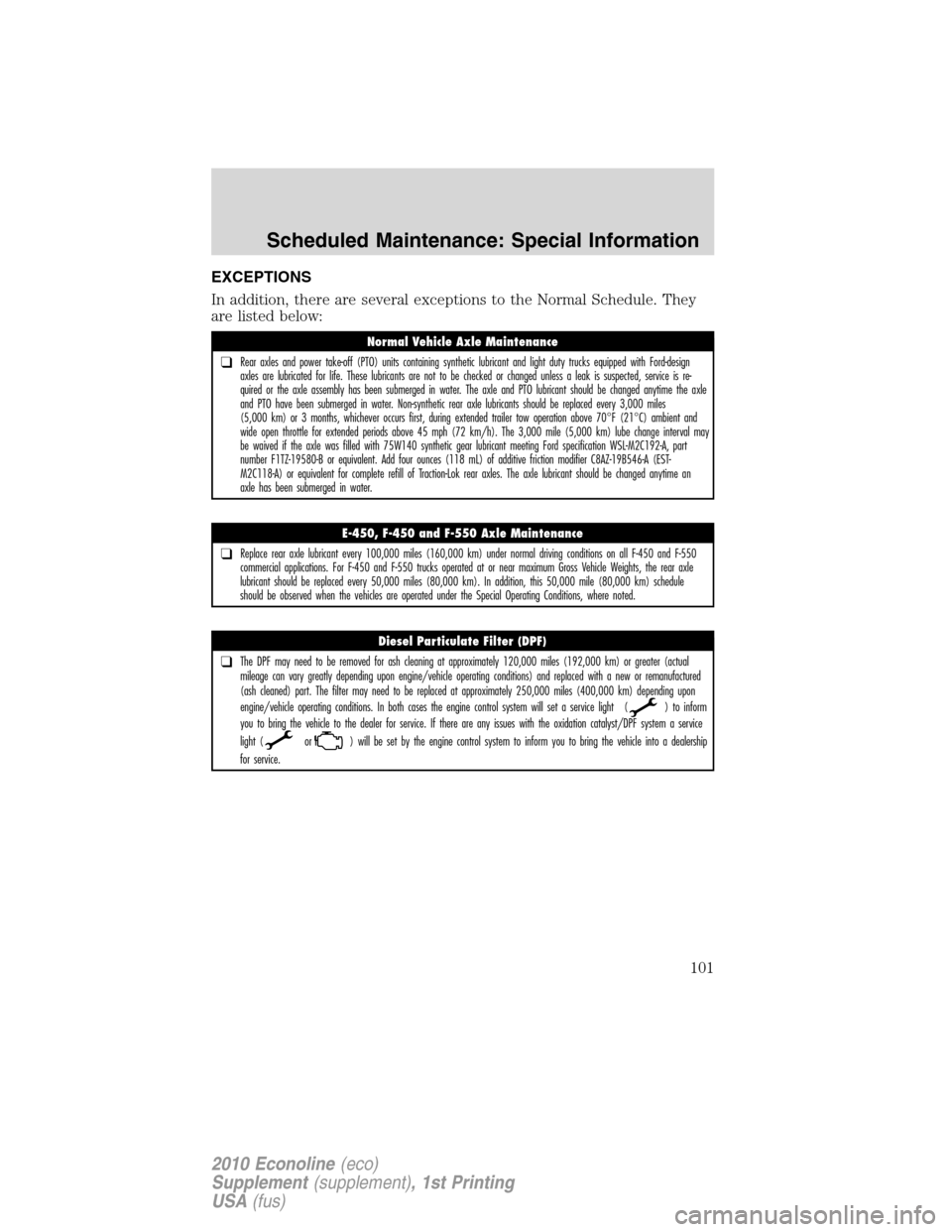
EXCEPTIONS
In addition, there are several exceptions to the Normal Schedule. They
are listed below:
Normal Vehicle Axle Maintenance
❑Rear axles and power take-off (PTO) units containing synthetic lubricant and light duty trucks equipped with Ford-design
axles are lubricated for life. These lubricants are not to be checked or changed unless a leak is suspected, service is re-
quired or the axle assembly has been submerged in water. The axle and PTO lubricant should be changed anytime the axle
and PTO have been submerged in water. Non-synthetic rear axle lubricants should be replaced every 3,000 miles
(5,000 km) or 3 months, whichever occurs first, during extended trailer tow operation above 70°F (21°C) ambient and
wide open throttle for extended periods above 45 mph (72 km/h). The 3,000 mile (5,000 km) lube change interval may
be waived if the axle was filled with 75W140 synthetic gear lubricant meeting Ford specification WSL-M2C192-A, part
number F1TZ-19580-B or equivalent. Add four ounces (118 mL) of additive friction modifier C8AZ-19B546-A (EST-
M2C118-A) or equivalent for complete refill of Traction-Lok rear axles. The axle lubricant should be changed anytime an
axle has been submerged in water.
E-450, F-450 and F-550 Axle Maintenance
❑Replace rear axle lubricant every 100,000 miles (160,000 km) under normal driving conditions on all F-450 and F-550
commercial applications. For F-450 and F-550 trucks operated at or near maximum Gross Vehicle Weights, the rear axle
lubricant should be replaced every 50,000 miles (80,000 km). In addition, this 50,000 mile (80,000 km) schedule
should be observed when the vehicles are operated under the Special Operating Conditions, where noted.
Diesel Particulate Filter (DPF)
❑The DPF may need to be removed for ash cleaning at approximately 120,000 miles (192,000 km) or greater (actual
mileage can vary greatly depending upon engine/vehicle operating conditions) and replaced with a new or remanufactured
(ash cleaned) part. The filter may need to be replaced at approximately 250,000 miles (400,000 km) depending upon
engine/vehicle operating conditions. In both cases the engine control system will set a service light (
) to inform
you to bring the vehicle to the dealer for service. If there are any issues with the oxidation catalyst/DPF system a service
light (
or) will be set by the engine control system to inform you to bring the vehicle into a dealership
for service.
Scheduled Maintenance: Special Information
101
2010 Econoline(eco)
Supplement(supplement), 1st Printing
USA(fus)